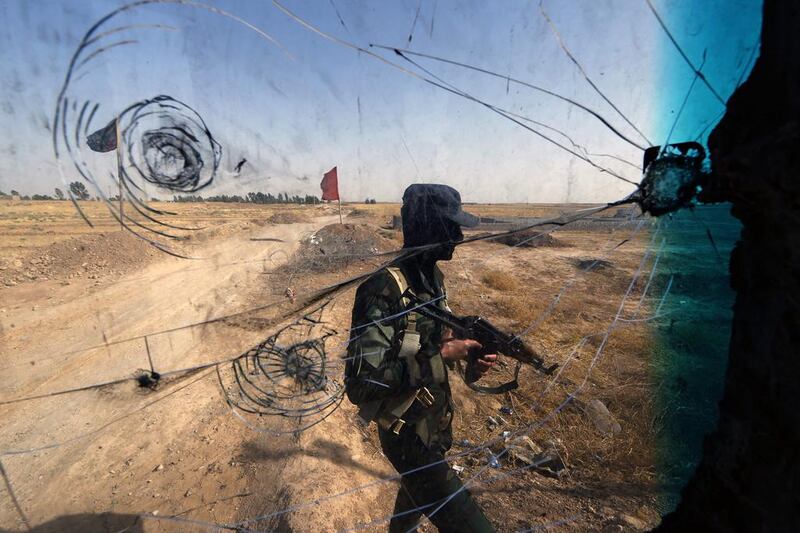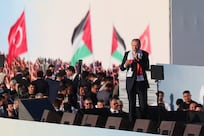As the US election continues its twists and turns, foreign policy only rarely rears it head. This week is an exception, for two reasons: one, the US president Barack Obama is bidding farewell to the Gulf and to Europe. And two, Hillary Clinton, hoping to succeed Mr Obama, has been burnishing her foreign policy credentials.
She has done this by agreeing to a long profile in The New York Times on her hawkish policy positions, most of which appear to be seeking to put some clear blue water between her and Mr Obama, particularly on Syria, and repeating her call for a no-fly zone in the north of the country.
Mrs Clinton, of the four candidates most likely to be president (Bernie Sanders, Donald Trump and Ted Cruz), has the most foreign policy experience. And yet, because of the experience of being a woman in a US presidential campaign, she has to fight to have her record remembered. Male candidates – we’re looking at you, Donald – can merely bluster about how tough they will be in office; Hillary has to show her work.
To that end, Mrs Clinton has returned to the theme of enforcing a no-fly zone, an idea mooted by many world leaders, Germany’s Angela Merkel and Turkey's Recep Tayyip Erdogan among them – but an idea, crucially, ruled out by Mr Obama.
For Mrs Clinton, a no-fly zone is both smart and dangerous politics.
Smart because it emphasises her hawkish credentials against Mr Obama, who has done little even as the Syrian conflict has raged out of control, and her foreign policy experience against the Republican contenders (both of whom have made only vague declarations of military force against ISIL).
But it is also dangerous, because of the legacy of the Iraq war and Mrs Clinton’s role in it. A viral video in the Middle East these days juxtaposes her laughing to an interviewer about the “hard choices” of Iraq with video of the devastating consequences that war had for Iraqis: burnt bodies, massacres, raped women. The message is unmistakable: the hardship was borne by the Iraqis, who were given no choice in the invasion.
The same criticism would be made of any intervention in Syria. It would be too difficult, too bloody, too politically charged. Enforcing a no-fly zone would be exceptionally difficult for Mr Obama in the final months of his presidency. For Mrs Clinton, in the first months of hers, it would be almost impossible, and would suck the oxygen out of US politics for months.
Yet even so, Mrs Clinton’s suggestion should be considered. The “realist” position on Syria is that it is too hard, too big a task to succeed.
The Russians have outmanoeuvre the West; the rebels are too divided and too radical; and ISIL needs to be the focus for now, which means working with the Assad regime.
The realist position, as taken by those negotiating with the regime, is that the “peace process” is the only option. This is the same peace process that led to the Assad regime retaking all of Aleppo. The same process that has seen Russian jets pound anti-Assad rebels. The same process that has all but guaranteed that Bashar Al Assad will remain president of Syria, even after five years of bloodshed. The same peace process that is, as I write, falling apart.
It should be obvious that there is no realist position on Syria. There are only unrealistic options. Perhaps it is unrealistic to imagine a no-fly zone in Syria – but it is certainly unrealistic to imagine that Mr Al Assad could re-establish control over Syria without mass bloodshed, torture and destruction. It is unrealistic to imagine that Syrians, after years of exile, would return to a country ruled by the man who through violence exiled them.
And it is certainly unrealistic to imagine that Turkey, Lebanon, Jordan and Iraq – to say nothing of European countries – could see their populations swell with Syrian refugees and continue as before.
Yes, a no-fly zone would be risky. More troops on the ground would be risky. Taking on Russian jets would be risky. But there are risks every way. The realist strategy is simply the status quo risk, pushing the risk out into the future and spreading it across time.
Doing nothing differently is also a risk, and in many ways the most substantial one. As it stands, the Syrian conflict has dragged on for five years – and could easily drag on in some form for another five. That scenario, while realistic, is apocalyptic for the Middle East and Europe. The costs of doing nothing are astronomical.
That’s why Mrs Clinton’s suggestion of a no-fly zone is worth considering. It shifts the debate back on to what can actively be done by the international community. Otherwise, by seeking the passivity of this peace process, we are merely sleepwalking back to the status quo – sleepwalking back to a Syria ruled by Bashar Al Assad’s iron fist. That is not a realist position. For Syrians, it is an unrealistic nightmare.
falyafai@thenational.ae
On Twitter: @FaisalAlYafai





